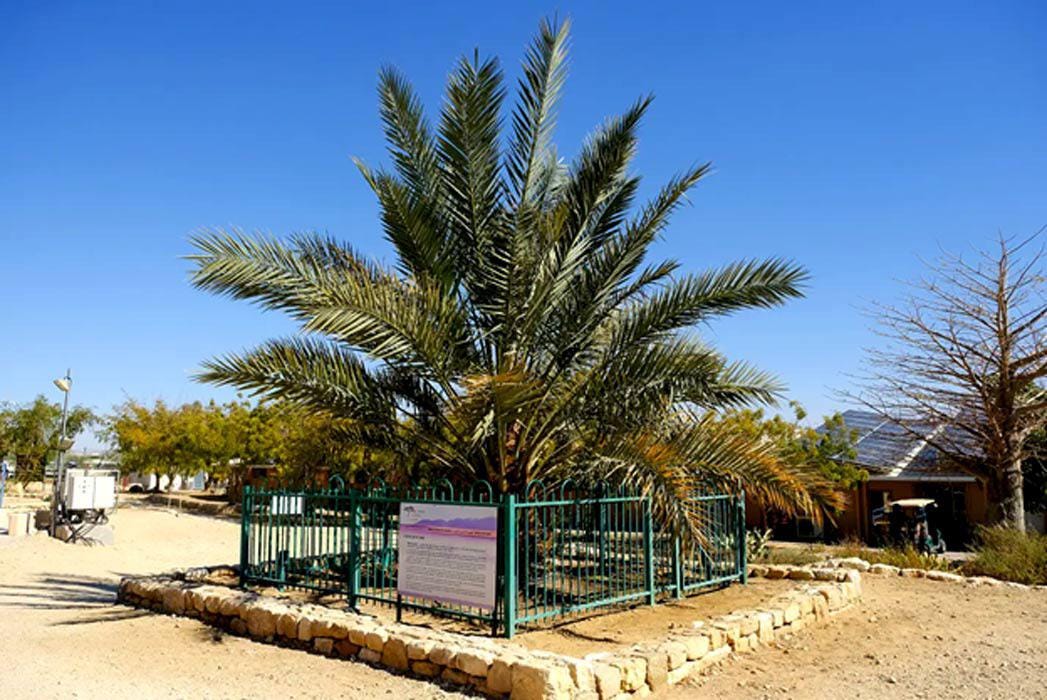A Thousand-Year-Old Seed Blooms into a Tree: Resurrection of a Biblical Species
It marks a monumental achievement, showing that even after a thousand years of dormancy, life can be reawakened and new possibilities can emerge from the distant past.
A Thousand-Year-Old Seed Blooms into a Tree:
The Discovery and Revival of "Sheba"
In a groundbreaking development, scientists have successfully revived a 1,000-year-old tree species from a single seed discovered in a cave in the Judean Desert. Nicknamed "Sheba," this remarkable seed lay dormant for centuries before being rediscovered during an archaeological excavation in the late 1980s. Radiocarbon dating revealed that the seed dates back to between 993 and 1202 CE. After 14 years of meticulous cultivation, the seed finally bloomed into a thriving tree, now standing at 10 feet (3 meters) tall.
The long and delicate process of reviving Sheba involved replicating the ancient plant's optimal growing conditions and carefully managing its growth cycle. This extraordinary feat of science demonstrates the possibilities within the realm of "resurrection genomics"—the ability to bring back species long thought to be extinct.
International Collaboration Led by Israeli Scientists
The successful revival of the ancient tree, "Sheba," was the result of a significant international collaboration, with primary leadership from Israeli researchers. The project was spearheaded by Dr. Sarah Sallon of the Louis Borick Natural Medicine Research Center at Hadassah University Medical Center in Jerusalem. She was supported by Dr. Elaine Solowey, an expert on desert plants from the Arava Institute of Environmental Science (AIES) in Israel.
The research also involved scientists from institutions in France, the United States, Switzerland, and Australia. The ancient seed was discovered in the Judean Desert, north of Jerusalem, and carefully nurtured into a thriving tree in Israel. Findings from this groundbreaking work were published in the journal Communications Biology, part of the Nature Publishing Group, showcasing the global efforts that led to the revival of a species with potential biblical and medicinal significance.
Botanical Classification and Significance
Sheba is believed to belong to the genus Commiphora, which is a part of the Burseraceae family—well known for producing myrrh and frankincense. The Commiphora genus consists of around 200 living species, primarily distributed across Africa, Madagascar, and the Arabian Peninsula. Although Sheba has yet to flower, making definitive species identification impossible, DNA analysis shows it shares close genetic ties with three known Commiphora species found in southern Africa.
The revival of this ancient tree is not only a scientific curiosity but also a window into the flora of the Judean Desert from a millennium ago. Sheba may represent a previously unknown or lost lineage of trees native to the Southern Levant, a region that encompasses modern-day Israel, Palestine, and Jordan.
Biblical Connections and Medicinal Properties
The potential significance of Sheba extends beyond its historical and botanical value. Researchers suspect that Sheba could be the long-lost source of the biblical "tsori," a resin mentioned in the books of Genesis, Jeremiah, and Ezekiel for its purported healing properties. The chemical composition of the tree supports this hypothesis, offering exciting possibilities for future medicinal use.
The tree is rich in pentacyclic triterpenoids, compounds with potent anti-inflammatory and anti-cancer properties. Additionally, Sheba's leaves and stems contain high levels of squalene, a substance known for its antioxidant qualities and skin-smoothing effects. This makes Sheba a promising candidate for therapeutic applications in modern medicine, particularly in the fields of cancer treatment and skincare.
The tree's revival has reignited interest in the medicinal wisdom of ancient cultures, offering insights into how the people of the Southern Levant may have used local plants to treat various ailments.
Implications and Future Research
The successful cultivation of Sheba is not just a scientific triumph but a leap forward for multiple disciplines, including botany, archaeology, and medicine. Its revival opens up exciting possibilities for future research:
Historical Flora: Sheba provides a unique glimpse into the plant life that once thrived in the Judean Desert, enriching our understanding of ancient ecosystems.
Biodiversity Conservation: This project demonstrates the potential for "resurrection genomics" to bring back extinct species or lost varieties, contributing to biodiversity conservation efforts globally.
Medicinal Discoveries: The tree’s chemical composition, particularly its anti-inflammatory and anti-cancer potential, could lead to the development of new drugs, pushing the boundaries of pharmaceutical research.
As researchers continue to study Sheba, they are hopeful it will eventually flower, allowing for further analysis and potential reproduction of this ancient species. The tree’s ability to produce reproductive material could pave the way for more detailed genetic studies, helping scientists understand how plants like Sheba adapted to ancient climates and environments.
The revival of Sheba highlights the powerful intersection of science and history, blending ancient wisdom with modern technology to achieve a monumental breakthrough. It demonstrates that even after a thousand years of dormancy, life can be reawakened, offering new possibilities from the distant past. This success not only holds promise for scientists exploring the medicinal potential of ancient species but also for environmentalists striving to preserve the planet's dwindling biodiversity. As this long-lost tree takes root once more, it stands as a living symbol of humanity’s enduring curiosity and its ability to reconnect with nature's ancient treasures.





Wonderful 👍